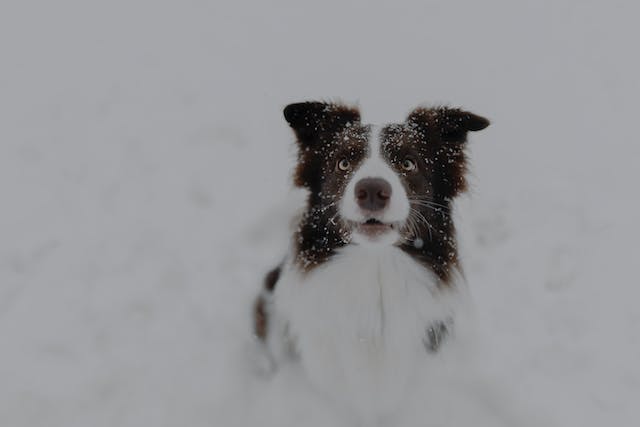How can I tell if my dog is cold? Let’s find out together…
In this quick and snappy blog post, I’ll show you the easy ways to tell if your doggo is feeling a bit frosty.
So grab a cup of coffee and let’s make sure our four-legged friends stay warm and cozy this winter!
Let’s dive in and find out how to tell if your dog is cold!
How Can I Tell If My Dog Is Cold
To determine if your dog is cold, observe their behavior and physical signs, such as shivering, hunching, and seeking warmth in blankets or warm spaces, also check if their ears, paws, or tail feel cold to the touch.
Notice if they are reluctant to go outside or show signs of discomfort in cold weather.
Keep in mind that small or short-haired dogs are more susceptible to cold and may require additional warmth.
If you suspect your dog is cold, provide them with a cozy, warm environment, or consider using dog clothing or blankets to keep them comfortable.
Let’s dive deeper for a better understanding…
Signs Your Dog is Cold

Here are some of the most common signs your dog is cold and what to do:
1. Hunched Posture
When dogs are feeling cold, they may adopt a hunched posture as a way to conserve body heat. By curling up or hunching their bodies, they minimize the amount of surface area exposed to the cold air.
This posture helps them retain warmth by reducing heat loss through their abdomen and extremities.
To manage a hunched posture, it’s important to provide your dog with a warm and comfortable place to rest.
Choose a cozy bed or blanket that provides insulation and helps retain body heat.
Consider placing the bed or blanket in a warm area of your home, away from drafts or cold surfaces.
You can also use a dog sweater or jacket to provide an extra layer of warmth when your dog goes outside in cold weather. These garments help trap body heat and protect your dog from the chilly air.
2. Hiding or Burrowing
When dogs are cold, they may seek out hiding spots or burrow into blankets, furniture, or even under the covers of your bed.
This behavior is an instinctual response to find warmth and comfort. By hiding or burrowing, dogs can create a cozy and insulated environment that helps them regulate their body temperature.
To manage this behavior, create a warm and inviting space for your dog. Provide them with a designated area where they can feel safe and warm, such as a crate with a cozy blanket or a heated dog bed.
Make sure the area is free from drafts and located away from cold surfaces like windows or doors. This will help your dog feel secure and provide them with a warm retreat.
Additionally, you can consider using a heating pad designed specifically for pets. These pads provide a gentle and controlled source of warmth that can be placed under your dog’s bedding.
However, it’s essential to use heating pads designed for pets to prevent burns or overheating. Always follow the manufacturer’s instructions and monitor your dog while using any heating device.
3. Cold Ears and Paws
When a dog is feeling cold, you may notice that their ears and paws are cold to the touch. This is because these areas are more exposed and vulnerable to the cold air.
Cold ears and paws can be uncomfortable for your dog and may even lead to issues like frostbite if left unaddressed.
To manage cold ears and paws, it’s important to keep these areas warm. Dog booties can be an excellent solution to protect your dog’s paws from the cold ground and provide insulation.
Look for booties that are designed to be weather-resistant and provide traction to prevent slipping. When choosing a size, make sure the booties fit properly and aren’t too tight or restrictive.
For your dog’s ears, you can use a dog sweater or jacket that covers their neck and ears. This extra layer of protection helps retain heat and keeps their ears warm.
Additionally, you can use warm compresses or blankets to gently warm your dog’s ears and paws if they feel cold to the touch. However, make sure the compresses are not too hot, as excessive heat can cause burns.
4. Seeking Warm Spots
When dogs feel cold, they often seek out warm spots in your home. This behavior is their way of trying to find a source of heat to keep themselves comfortable.
You may notice your dog trying to cuddle up on your bed, lying near heat sources like radiators or vents, or even burrowing under blankets.
To manage this sign, it’s important to provide your dog with warm and comfortable bedding in a draft-free area of your home.
Make sure their bed is placed away from windows or doors where cold drafts may be present. You can also consider using blankets or heated pet beds to provide extra warmth. These provide a cozy and inviting space for your dog to relax and stay warm.
5. Curling Up
When dogs curl up tightly into a ball, it is a natural instinct to conserve body heat and stay warm.
You may notice your dog tucking their paws under their body and wrapping their tail around itself when they are feeling cold.
To manage this sign, you can provide your dog with a warm and snug shelter or create a cozy space for them indoors.
If your dog spends time outdoors, make sure they have access to a well-insulated doghouse or shelter that can protect them from the cold and wind.
Inside your home, you can create a comfortable space for your dog by using blankets or pillows to create a warm and secure area. This can help them feel safe and warm during colder temperatures.
6. Shivering or Trembling
Shivering or trembling is a common sign that dogs exhibit when they are cold. It is their body’s natural response to generate heat and maintain their body temperature.
You may notice your dog’s muscles contracting and their body shaking uncontrollably when they are feeling cold.
To manage this sign, it’s important to provide your dog with extra layers of warmth. Consider using dog sweaters or jackets specifically designed for dogs to help keep them insulated.
These clothing items are available in various sizes and styles, allowing you to choose the most suitable option for your dog. Additionally, you can adjust the temperature in your home to provide a warmer environment for your dog.
If necessary, you can use space heaters or heating pads (under supervision) to create a cozy space for your dog to alleviate their shivering or trembling.
7. Change in Behavior

Dogs may exhibit changes in behavior when they are feeling cold. They may become more withdrawn, seek warmth, or show signs of discomfort.
You might notice your dog curling up tightly, tucking their tail between their legs, or seeking out warm spots in the house.
To manage this, provide your dog with a warm and comfortable environment. Make sure they have access to a cozy bed or blanket in a draft-free area.
Consider using a heated dog bed or placing a heating pad beneath their bed. You can also create a warm space by using a space heater, but always ensure it is safe and monitor your dog to prevent any accidents.
8. Whining or Vocalization
Dogs may whine or vocalize when they are feeling cold as a way to communicate their discomfort. They might also paw at you or try to get your attention in other ways.
To manage this, address the source of the cold. Check for any drafts in the house and make sure your dog’s bed is not placed near windows or doors. Use weatherstripping or draft stoppers to seal any gaps.
Consider using a dog sweater or coat to provide extra insulation when taking your dog outside in colder temperatures. Additionally, you can provide warm blankets or towels for your dog to snuggle with.
9. Clumsiness
Cold temperatures can cause dogs to become clumsy or have difficulty moving. This can be due to muscle stiffness or discomfort caused by the cold. You might notice your dog hesitating to walk or having trouble with coordination.
To manage this, provide your dog with a warm and comfortable environment. Keep their living area well-insulated by using curtains or insulated dog houses.
Consider using heating pads or blankets to provide additional warmth, but always ensure your dog cannot chew on or get tangled in them.
Regular exercise can also help to keep your dog’s muscles warm and prevent stiffness. Warm-up exercises before walks can be beneficial as well.
10. Lifting Paw off the Ground
When a dog is cold, one common sign is lifting its paw off the ground. Dogs do this as a way of protecting their sensitive paws from the cold and discomfort of frosty ground surfaces.
It’s important to remember that dogs lose a lot of their body heat through their paws, so when they feel cold they may instinctively lift their paws to reduce the loss of heat.
To manage this, you can provide a warm and comfortable sleeping area for your dog. This could be a soft, insulated dog bed or simply a selection of warm blankets.
Also, during walks or outdoor activities in cold weather, consider using dog booties or paw wax. These products are designed to protect your dog’s paws from the cold and can make walks more comfortable for them.
Additionally, if the weather is extremely cold, consider limiting outdoor activities and providing indoor playtime instead. This can help to reduce the exposure of your dog’s paws to cold surfaces.
11. Excessive Sleepiness or Lethargy
If your dog is excessively sleepy or lethargic, this can be a sign that they are feeling cold.
Dogs, like many animals, have a natural instinct to conserve energy when they’re cold in order to maintain their body temperature. This can result in them being less active and sleeping more than usual.
To manage this, ensure that your dog has a warm and comfortable place to sleep. Keep your home at a temperature that is comfortable for your dog and consider using a heated dog bed or providing extra blankets for them to snuggle up in.
If your dog spends a lot of time outdoors, consider providing a well-insulated dog house.
Also, consider using dog sweaters or jackets to provide additional warmth during outdoor activities. These can be particularly beneficial for dogs with short hair or those that are not naturally adapted to cold weather.
What to Do if My Dog is Cold

If your dog appears cold, first and foremost, move it to a warmer location and provide a cozy blanket for immediate relief.
Consider purchasing a dog coat or sweater, especially for breeds with thin fur. Make sure your dog’s sleeping area is warm and well-insulated, away from drafts or dampness.
Provide a heated bed or a self-warming pet mat for extra warmth. Always ensure your dog is well-fed and hydrated as nutrition plays a key role in maintaining body temperature.
Lastly, during cold weather, limit outdoor time and avoid cold surfaces like snow, which can lower your dog’s body temperature.
Frequently Asked Questions
What are the signs my dog is feeling cold?
Dogs exhibit various signs when they’re feeling cold. Look for shivering, seeking warm spots, curling up tightly, or attempting to burrow under blankets or furniture.
Are certain dog breeds more sensitive to the cold?
Yes, some dog breeds are more susceptible to cold temperatures than others. Breeds with short hair, thin coats, or smaller body sizes, like Chihuahuas or Greyhounds, may feel the cold more intensely.
Can I use a thermometer to check my dog’s body temperature?
While using a thermometer to measure your dog’s body temperature is possible, it’s not recommended for regular monitoring. Instead, focus on observing their behavior and physical signs to determine if they’re feeling cold.
Should I dress my dog in winter clothing?
If your dog shows signs of being cold, investing in a dog sweater or jacket can help keep them warm during chilly weather. However, not all dogs enjoy wearing clothing, so consider their comfort and personality before dressing them up.
Can I leave my dog outside in cold weather?
It’s generally not advisable to leave your dog outside in cold weather for extended periods. Dogs can suffer from hypothermia or frostbite, so it’s best to bring them indoors or provide them with a warm and sheltered space.
Are there any signs of frostbite I should watch out for?
Yes, signs of frostbite in dogs include pale or blue skin, cold and firm areas on their body, pain or discomfort when touched, or blisters and ulcers. If you suspect frostbite, seek immediate veterinary attention.
Read more about improving your dog’s health.
Conclusion
In conclusion, keeping an eye on your furry friend’s behavior and body language is key to determining if they’re feeling chilly. Look out for shivering, seeking warmth, or curling up in a ball as signs that your dog may be cold. Remember, just like us, dogs appreciate some extra warmth and comfort during the colder months. Stay cozy and keep your pup snug as a bug!


